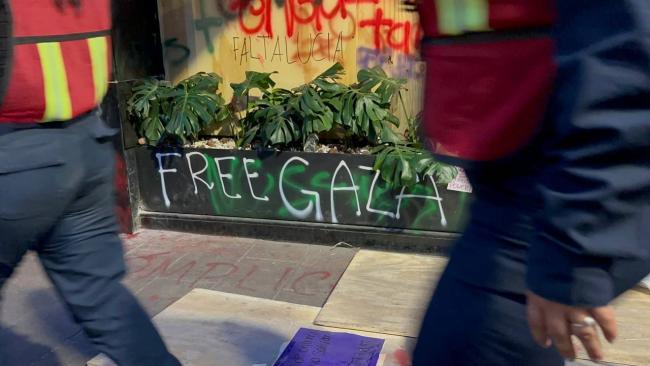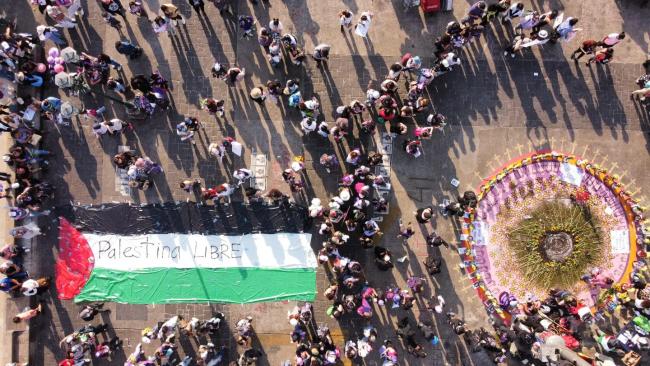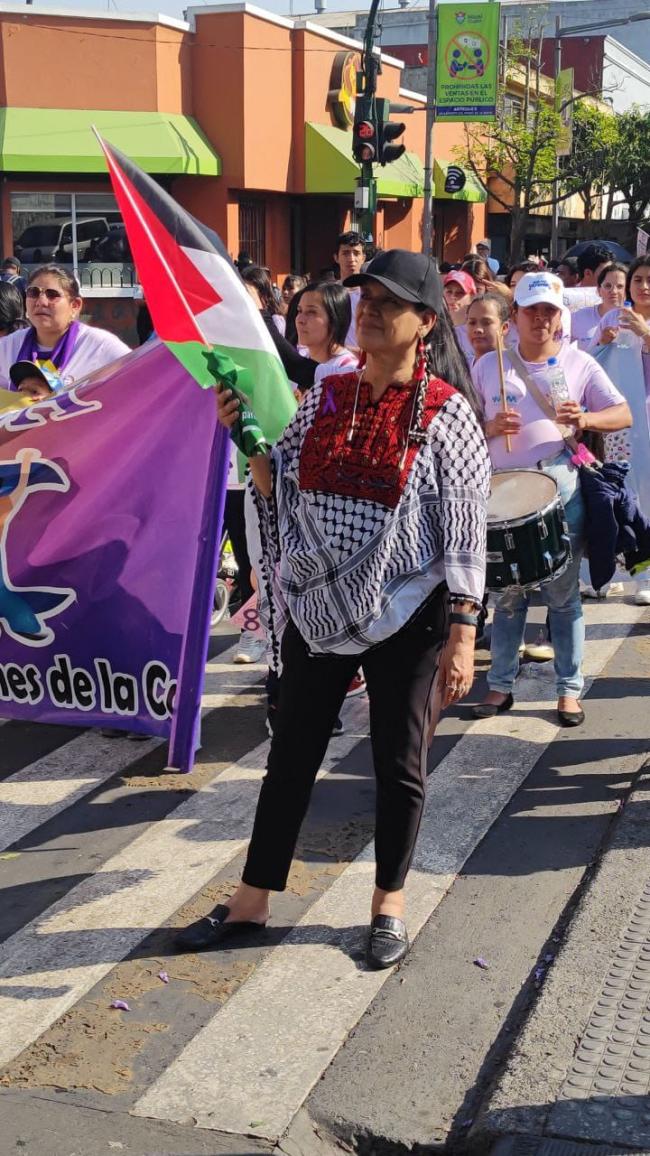
Leer este artículo en español.
This article was originally published by CounterPunch.
It was on the streets of Guatemala City in 1987 when I began awakening to Israel’s partnership with the USA in facilitating genocide.
Today we are “seeing genocide”–a decades-long cumulative “genocidal condition”–being played out, as Israeli Modern Culture and Media Professor, Ariella Aisha Azoulay argues. We see it in the US/Israeli onslaught against Gaza. My memories and knowledge return to reflect on Israel’s connection to genocidal practice, not only in Gaza but also in Guatemala.
In Guatemala of the 1980s, a counterinsurgency by U.S.-backed military governments slaughtered Maya indigenous and tens of thousands of other dissidents and suspects. There was no social media to cover it. Most American citizens knew nothing of it. The killing of this period in Guatemala has been recognized as “genocide” by official analysts and by a thorough 12-volume investigative report. This latter study made clear the appropriateness of the phrase “acts of genocide” to name the crimes of Guatemala’s military against the Maya, in spite of the military’s claim that they lacked “intent” to commit genocide, that it was only motivated by economic, political or military concerns. As with Israel in Gaza of Palestine, so with Guatemalan elites relative to the indigenous Maya, it is the historical record of decades of accumulative killing, occupation, forced removal and dehumanization, which establish the acts and conditions as those of genocide.
The studies of Guatemala’s genocide, as I will show, reveal also the special role of Israel in that slaughter under the aegis of US imperial interests.
Backing State Terrorism in Guatemala
I was first in Guatemala in 1987 to interview educators and activists who were important for my research about the role of religious beliefs among Maya indigenous peoples as they waged resistance to their ongoing repression. 1987 was a date when Guatemala’s latest series of military governments had just passed the worst of mass violence against Maya communities, the worst occurring between 1981 and 1983. The period is often called a “hidden/silent holocaust,” the “Guatemala holocaust” or the “Maya holocaust.” And this is only one site of Israel’s involvement with massive state violence and terrorism throughout Latin America. I had been working with Guatemalans and others in the US to seek an end to U.S. military aid to Guatemala.
Simultaneous to my research, I was also in Guatemala to set up a program for students, one that I ran at Princeton Theological Seminary for almost 15 years. It placed our students in Central America, usually in Guatemala, for 8-weeks of summer learning programs–not for missions, building projects, but primarily for accompaniment, listening, and mutual understanding. Setting up this program through consultations with many Guatemalans, and then guiding students through this program remains one of the most valuable of my experiences over 40-plus years of teaching at Princeton.
One day in 1987, as the dust and smog of a Guatemala City street swirled about me, I walked in conversation with an activist friend and mentor. We were interrupted, startled by a loud order given by an authoritative command, projected by a deep vibrating loudspeaker. Call it a Darth Vader like sound-only sharper, slightly higher pitched, more threatening at high volume.
“What?” I gasped with irritation.
“Oh yeah,” clarified my colleague, “Witness our new police vehicles, courtesy of the Israeli Government.”
“Israel in Guatemala?” This disturbed me and started a line of thinking that persisted in my research and writing for decades. The Israeli state’s destruction of over 400-500 villages in Palestine of 1947/1948 would for subsequent decades be linked in my mind with the destruction of a similar number of villages destroyed in Guatemala in the early 1980s. My thinking on this part of the tangled web of world genocidal outcomes became a life-long concern in my research and publications.
I knew something of Israel’s history of war and repression in Palestine, but I did not know then, in 1987, of its connections to supplying police and military equipment as well as advisors in technology and surveillance to Guatemala. The nation’s police institutions were networked with military and surveillance agencies. These armed agents of state became fearsome threats to its citizens and brutal actors, especially after the 1954 CIA orchestrated coup against Guatemala’s last democratically-elected government.
The worst of the massacres in Maya villages were part of large military “sweeps” through Guatemala’s northern and western highlands. U.S. Colonel George Maynes told journalist Allan Nairn that he had worked with Guatemalan General Benedicto Lucas Garcia to develop this sweep tactic. During the presidency of Pentecostal general Efraín Ríos Montt, this sweep tactic was developed in March 1982 into a systematic strategy against the Maya who were seen as the major “internal enemy” to the Guatemalan state. Nairn also reports that U.S. Green Beret, Captain Jesse Garcia was even more specific about how he “was training Guatemalan troops in the technique of how to ‘destroy towns’.” Maya indigenous suffered over 625 massacres and also, by the government’s own admission, the near total destruction of more than 600 villages in Guatemala’s rural highlands. 100,000 fled to Mexico, over a million displaced within Guatemala.
It was not just the Maya indigenous who suffered such atrocity. Urban, non-indigenous dissidents or suspects were also rounded up and often interrogated, tortured, disappeared. Over a million pages of reports from Guatemalan police archives—yes, over a million pages now retrieved—confirm this. Overall, more than 200,000 people were killed or disappeared in this war in Guatemala between 1960 and 1996.
In a later visit with seminary students in 1988 and accompanied by my family and my two young children, I visited the forensics unit of Grupo de Apoyo Mutuo (Mutual Support Group) in a small building in Guatemala City run by the country’s las madres de los desaparecidos (“mothers of the disappeared”). The next morning, we saw in the newspapers that the building had been firebombed by police forces. Families looking for their disappeared loved ones (and doing so with the support of international delegations of which I was a part), all seeking forensic information that might expose those culpable for the disappeared–this was a crime in Guatemala in these years. The pervasiveness of violence in Guatemala, and the U.S. role in sustaining it, was dramatically marked for me by this encounter.
Scorched Earth and “Palestinization”
Israel’s connection to all this has been extensively researched. It became heavily involved with Guatemala’s military government, especially when US President Jimmy Carter in 1977 cut off most of US military aid to Guatemala due to its notorious record of human rights abuses. Investigative journalist George Black, writing for NACLA, reported that Israel eagerly stepped in for the US, becoming “Guatemala’s principal supplier. In 1980, the Army was fully re-equipped with Galil rifles [Israeli manufactured] at a cost of $6 million.” In later years, Guatemalan military elites were proud that they had quelled the insurgency largely without US aid. Israel had played a much-valued proxy role for US military suppliers.

In an infamous massacre, one of many, the Israeli connection was clearly present. At the village of Dos Erres on December 6, 1982. Israeli-trained commandos left the village completely burned down, after shooting, torturing and/or raping over 200 villagers. A UN investigative team reported: “All the ballistic evidence recovered corresponded to bullet fragments from firearms and pods of Galil rifles made in Israel.” This was just in the one village of Dos Erres. The same 12-volume investigation reports that Israeli made Galil rifles were used throughout the highlands, while US-made helicopters ferried troops into the highlands for what the report argues were “acts of genocide.”
Alas, it took me too long to learn how many were the other ways that Israel had been involved in Guatemala’s massive state violence. Harvard-trained political scientist Bishara Bahbah in his book, Israel, and Latin America: The Military Connection (1986) termed Israeli military aid to Guatemala “A Special Case” within a larger set of Israel’s armament sales to Latin America over the decades. Other works make similar points, such as the study by Milton Jamail and Margo Gutierrez, It’s No Secret: Israel’s Military Involvement in Central America.
Scholars continue to study Israel’s military contribution to militarizing today’s global order. Israel is adept at marketing itself as provider of technology for the “pacification” of the global order’s trouble spots. Israeli anthropologist, Jeff Halper, documents this at length in his book, War Against the People: Israel, The Palestinians, and Global Pacification. Halper notes that in Guatemala, Israel’s military aid and training were instrumental in setting up forced-settlement, “re-adjustment” communities, or “model villages” designed to monitor massacre survivors. Guatemalan military officers referred to such strategies as a “Palestinization” of Guatemala’s post-massacre Maya lands, where shock and awe and scorched earth campaigns left a devastated people. Guatemala-born journalist, Victor Perera described the result “a distorted replica of rural Israel.” Ian Almond, who recounted Perera’s description stated that Israeli trained, Guatemalan Colonel Eduardo Wohlers, in charge of the Plan of Assistance to Conflict Areas, admitted, “The model of the kibbutz and moshav is planted firmly in our minds.”
Here are just a few further notes on Israel’s Guatemala connection:
As early as 1978, joint discussions taking place in Israel, between Israeli and Guatemalan defense ministers, focused on “the supply of weapons, munitions, military communications equipment (including a computer system, tanks and armored cars, field kitchens, other security items and even the possible supply of the advanced fighter aircraft, the Kfir. They also talked about sending Israeli personnel . . . to train and advise the Guatemalan army and the internal security police (known as G-2) in counterinsurgency tactics.”
As the Guatemalan sweeps against the Maya were beginning, in November of 1981, the United States and Israel signed the Memorandum of Understanding Concerning Strategic Cooperation. It focused on their joint efforts “outside the east Mediterranean zone.”
Israel started delivering its Arava STOL utility planes in 1977, purportedly only for transporting non-military supplies, but as advertised by Israelis the planes are “quickly convertible” to other purposes, even into being “a substitute for the helicopter.” They were used for counterinsurgency activity in the Guatemala.
General Benedicto Lucas Garcia, Chief of Staff of the Guatemalan military and who implemented the genocidal sweeps, expressed appreciation for ” ‘the advice and transfer of electronic technology’ from Israel: when he was speaking at a special ceremony for opening the Guatemalan Army School of Transmission and Electronics.

According to one comprehensive summary of Israel’s role in “Guatemala’s Dirty War,” journalist Gabriel Schivone wrote in The Electronic Intifada about how Israel pursued this proxy role for the U.S. One Israeli minister of economy, Yaakov Meridor stated: “We will say to the Americans: Don’t compete with us in Taiwan; don’t compete with us in South Africa; don’t compete with us in the Caribbean or in other places where you cannot sell arms directly. Let us do it . . . Israel will be your intermediary.”
Consider Israeli General Mattityalu Peled, who was a trained fighter for Israel with the early elite Zionist paramilitary Haganah, a military administrator over occupied Gaza in the late 1950s, and also a general during the 1967 war. Peled gave an honest explanation of Israel’s role in the global arms market: “Israel has given its soldiers practical training in the art of oppression and in methods of collective punishment. It is no wonder, then, that after their release from the army, some of those officers choose to make use of their knowledge in the service of dictators and that those dictators are pleased to take in the Israeli experts.”
President Ríos Montt’s 1982 coup, as he himself explained to ABC News, carried the day because “many of our soldiers were trained by the Israelis.” Israeli trainers and advisors for both military and police actions were reported to be at 150-200 in number, some reports stating 300. As the killing in the highlands was at its height, Ríos Montt’s chief of staff, General Hector Lopez Fuentes admitted, “Israel is our principal supplier of arms and the number one friend of Guatemala in the world.”
One Israeli advisor who worked extensively in Guatemala, Lieutenant Colonel Amatzia Shuali, had clearly taken the Israeli government’s message to heart. Shuali mentioned to a fellow Israeli, “I don’t care what the Gentiles do with the arms. The main thing is that the Jews profit.” The interviewer added, “Shuali was too polite to make such a remark to a non-Israeli.” Shuali’s attitude was similar to that coming from the lips of a former head of the Knesset foreign relations committee. About Israel’s relationship to Guatemala, the Knesset member explained: “Israel is a pariah state, we cannot afford to ask questions about ideology. The only type of regime that Israel would not aid would be one that is anti-American”.
Another key Israeli strategist, Pesakh Ben Or, “perhaps the most prominent Israeli in Guatemala” in the 1980s, was an agent for Israel Military Industries and for Tadiran (an Israeli telecom group that serviced the military and surveillance offices at the Guatemalan National Palace). He managed also to maintain “a villa near Ramlah in Israel, complete with Guatemalan servants, pool and stabling for seven racehorses.”
Beyond Military Aid
Much of Israel’s military aid is part of an assistance mesh that includes agricultural aid. A NACLA report by investigative journalist George Black summarized from Guatemala: “. . . there is an interlocking mosaic of assistance programs–weapons to help the Guatemalan Army crush the opposition and lay waste to the countryside, security and intelligence advice to control the local population, and agrarian development models to construct on the ashes of the highlands.”
According to the Stockholm International Peace Research Institute, as Bahbah summarizes, “With Israeli help, Guatemala even built a munitions plant to manufacture bullets for M-16, and Galil assault rifles.” This plant was opened in the Guatemala town of Coban, a place in which I and my students had visited to interview activists and church leaders.
Fifteen years of research and consultation with scholars more expert than me on Guatemala have kept me attuned to the US/Israel/Guatemala military connections. There is more research on the connections during the years of genocide in Guatemala than I can summarize here. I have found the similar patterns of Israeli/US partnership when making visits to other sites of US military interventions, overt and covert (in Peru, Colombia, Honduras, El Salvador, Nicaragua and Chiapas, Mexico). These countries, too–but especially and always Guatemala–gave me a first window out onto the US and Israel as partners in genocide. Now, especially within the U.S., I as a citizen have to reckon with my share of responsibility in all this, given the $3.8 billion dollars per year in military aid that the US sends to Israel to preserve these ways of violence against Palestinians and Guatemalans.
Our pro-Palestinian movements must rise to challenge, once and for all, this US/Israel partnership in the genocidal condition.
See the original article for additional notes and citations by the author.
Mark Lewis Taylor is Maxwell Upson Professor of Theology and Culture, Princeton Theological Seminary.
Images in this article are courtesy of Festivales Solidarios (IG: @festivalesgt, TW: @festivalesgt), a non-profit organization in Guatemala, run by media specialists and journalists that aim to serve as a digital, anti-colonial loudspeaker for "the pueblo" (the people).

